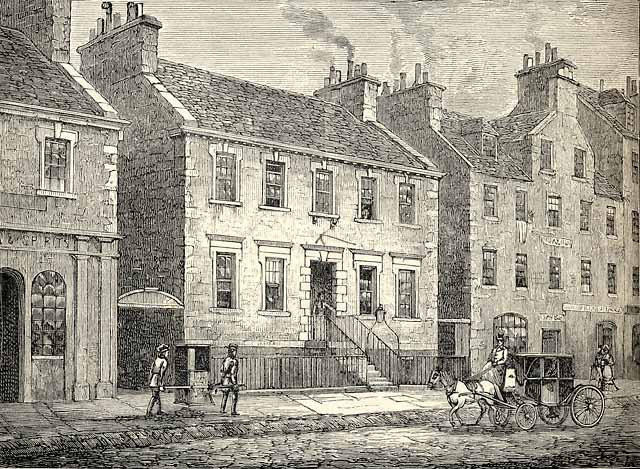It’s all due to this notice, which appeared in The Scotsman, Saturday, 8th December 1832, that I’m able to state with confidence that the Thomas Sutherland who was the proprietor of Sutherland and Son, Tailors, at 47 Nicolson Street, Edinburgh was the TS (married to Grace Hogg) who came to Canada in 1833 to found Mooretown:
ADVANTAGEOUS OPPORTUNITY
SUTHERLAND & SON, TAILORS, 47, Nicolson Street, having made arrangements to leave this country for America in April next, will be glad to make arrangements with a respectable person to succeed them, upon very favorable terms, as little more than the value of Counters, Shelving, &c. will be expected. The rent is moderate, and the business has been long established. Applications by post must be paid.Edinburgh, 8th Dec. 1832.
As per a Sutherland history, “The family left Leith, Scotland, on April 25, 1833, aboard the ship European, commanded by Captain Andrew Scott of Leith, arriving in Quebec City on June 21, 1833.” The departure of the European under Scott, bound for
TS was already located at 91 Nicolson Street by 1806, as the Post Office Directory of that year lists a “Thomas Sutherland Tailor.” In 1810 he relocated to 12 Nicolson Street, and the following year to 23, where he was still located in 1827. An 1824 advertisement gives the occupation as tailor and clothier. By 1829 the business had expanded to “Sutherland and Son.” That Sutherland relocated frequently is not surprising; many merchants and craftsmen relocated regularly, due to fluctuating finances or conflicts with landlords (see, for instance, members of Scotland’s Book Trade).
It seems likely that Sutherland was in pursuit of the best deal, but did not want to move too far for risk of losing his clients. He was clearly invested in a competetive marketplace for renters, as demonstrated by an announcement in The Scotsman dated July 6, 1831. The piece opens:
THE COMMITTEE of the INHABITANTS beg earnestly to call the attention of the Householders and Proprietors of Edinburgh, to the Petitions to the House of Lords and Commons, against the Improvement Tax, which lie for signature at the following places: — Mr. William Tait, 78, Prince’s Street; Mr. Adam Stewart, 38, Howe Street; Mr James Affleck, Clerk Street; Mr. Chambers, bookseller, 23, Broughton Street; Mr Thomas Sutherland, 47, Nicolson Street; Mr John Boyd, 37 George Street, and Mr Weston, Bookseller, Lothian Street.
While 47 Nicolson was a residential address, TS clearly had his home elsewhere (more on that later). We know a bit about this, his final store, because a later landlord, William Darling, altered the property from what it had been at the time of TS’s tenancy, “A dwelling-house bounded on the east by Nicolson Street and on the north by Nicolson Square, Edinburgh, consisting of four stories, one of which has a sunk story with an area in front.” Darling converted the street flat into a shop in 1843, which suggests it had not formally been one before.


No comments:
Post a Comment